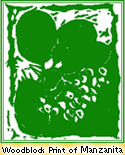

Please check out our new website at YerbaBuenaNursery.com
We are keeping this site alive while we continue to port all of the content over to the new site.
Please note. We are not actively maintaining this site. Prices and inventory are not current or correct.
For correct pricing and inventory, please visit the new site
Container Gardening with Native Plants
Garden Guides | At Your Home Garden Design Service | We've Gone Native Planting Service | Garden Tune-Up Service
Container Gardening Guide, Your Questions Answered
Why Grow Natives in Containers?
Can Natives be Drought Tolerant in Containers?
Attracting Birds, Butterflies and Pollinators
How Long Can You Keep Natives in Containers?
Soil to Use
Mulches for the Top Surface
Pots to Use
Drainage Issues - (Don't Use a Saucer Without Pot Feet)
Watering Needs are Different than for Natives Grown In-Ground
Moisture Meter?
Fertilizer Needs
Position in the Sun
Pruning Requirements
Planting Multiple Species in the Same Pot
Unusual Containers
Can Natives be Drought Tolerant in Containers?
Attracting Birds, Butterflies and Pollinators
How Long Can You Keep Natives in Containers?
Soil to Use
Mulches for the Top Surface
Pots to Use
Drainage Issues - (Don't Use a Saucer Without Pot Feet)
Watering Needs are Different than for Natives Grown In-Ground
Moisture Meter?
Fertilizer Needs
Position in the Sun
Pruning Requirements
Planting Multiple Species in the Same Pot
Unusual Containers
Yerba Buena Nursery's Favorite Natives for Container Gardening
Getting Started with Example Plant Groupings
|
Container Gardening Guide, Your Questions Answered |
|
Why Grow Natives in Containers? Growing natives in containers is a great way to add color and wildlife activity to an area of your yard that may not be appropriate for planting in the ground, such as on a patio or table, or along a front walk or porch. Also, using interesting containers among plants established in the ground can add interest and diversity to your garden. Finally, there are some natives that are much more easily grown in containers than in the ground, such as many of the showy succulents and alpine plants found in our state. |
|
Can Natives be Drought Tolerant in Containers? Many natives that are drought tolerant in the ground will need regular water in pots, due to their normally wide-spreading root systems being confined. That said, it is important not to give drought tolerant natives too much water when growing them in pots - they still want to remain a little on the dry side. There are however a few natives that can be considered truly drought tolerant in pots - many native bulbs that have adapted to summer dormancy, and the various native succulents such as Dudleyas, Lewisias, and Sedums. These plants are adapted to storing water in their fleshy leaves so can withstand up to several weeks between watering. For native bulbs such as Calochortus and Triteleia, the pots can be placed in a shady place after the bulbs begin to go dormant in late spring, and not watered again until the fall rains. |
|
Attracting Birds, Butterflies and Pollinators Many of the same plants that attract bees, birds, and butterflies to your in-ground garden can be used to good effect in containers. A box outside your kitchen window with Buckwheat and Penstemon can attract bees, butterflies, and hummingbirds from spring into late summer. Since plants that are cared for in pots often bloom longer than their relatives in the ground, they can provide a valuable late-season source of pollen and nectar. |
|
How Long Can You Keep Natives in Containers? With a little maintenance, most natives can be kept in pots for at least three years, if not much longer. The exact length of time varies depending on the variety of plant and the size of the pot. Sooner or later, almost all potted plants will become potbound to the point that it affects their vigor. You will notice this by a general yellowing of the plant, slowed or stopped new growth, and an almost immediate drying out of the pot after watering, as the roots are wound densely around the bottom and sides of the container. The solution to this problem is to remove the tangled roots and refresh the soil. This is accomplished through several steps (note that having an extra pair of hands around will make this a lot easier!):
|
|
Soil to Use Most potting soil found at the garden center is not appropriate for natives (truthfully, a lot of it isn't appropriate for any plant). Many brands do not drain well, have far too much fertilizer already incorporated, and/or break down into a poorly draining soupy muck within a year or two. However, garden centers do carry the ingredients to produce your own long lasting, properly draining and nutrient providing mix for your natives. If mixing your own soil doesn't appeal to you, Yerba Buena Nursery sells bags of our standard potting mix which works well for many natives. Alternately, most brands of Cactus soil work adequately for natives, since they usually drain well and do not contain too much fertilizer. A common mistake many people make is to incorporate a portion of garden soil into their containers when using native plants, in the assumption that the native plants will appreciate the native soil. The dynamics of water retention and drainage are very different in a container than in the ground, and the small particle size of garden soil causes the pot to dry out very slowly, which is definitely something you don't want. I can't think of a single plant species I've grown that would benefit from the additon of garden soil to the pot. Basic Mix We use a very similar recipe for most of our plants here at the nursery.
We use this mix for plants requiring excellent drainage. Keep in mind that it drains (and dries out) very rapidly, but the chances of overwatering a sensitive plant are greatly diminished.
|
|
Mulches for the Top Surface Mulch is a layer of chunky material that keeps the surface roots of the plant cool and limits evaporation, reducing the amount you need to water. Depending on what plant you are growing, there are a few readily available options.
|
|
Pots to Use The two main issues when choosing a pot are the ability to drain water freely, and the size. Unfortunately, many lovely pots only contain one hole the size of a nickel in the bottom, which will not drain well enough to grow any native except those that like lots of water, such as Rushes, Horsetail, or other streamside plants. A pot will ideally have a few holes in the bottom, or one at least the size of a quarter. It is possible, but difficult to grow most natives in a pot with just one small drainage hole, especially in the winter when the pot is likely to stay saturated for long periods. Choosing the right size container depends on two things: the current size of the plant you are planting, and its eventual size. Planting a 1 gallon Manzanita into a wine barrel will probably not work very well. A 5 gallon Coffeeberry planted into a clay pot a few inches wider will not take long to become potbound. Ideally, replant into a pot with 2-4 times the volume of the current pot. A pot much smaller than this will typically become rootbound and dry out quickly, whereas transplanting into a much larger container usually leads to the plant remaining too wet and languishing. If you wish to grow a 1 gallon Manzanita into a large specimen in a big urn or wine barrel, the best strategy is to repot it into a slightly larger container for a couple of successive years, until its rootball is at least 1/4 the size of the final container. As "container gardeners" here at the nursery, we follow the exact same strategy, potting seedlings into 2' wide containers, then 1 gallon pots, then 5 gallon pots, and so on. Potting a seedling into a 15 gallon pot would save us lots of labor, but with few exceptions would not produce a healthy plant. |
|
Drainage Issues - (Don't Use a Saucer Without Pot Feet) With the exception of the relatively few natives that like "wet feet", there will need to be a gap of at least 1/2" of free space beneath the pot. If a saucer is used to protect the surface the pot is on, spacers should be placed between the pot and saucer so that the plant is not sitting in a pool of water. Exceptions to this rule are our bog and streamside natives, which thrive in a constantly moist, even saturated environment. |
|
Watering Needs are Different than for Natives Grown In-Ground You are running a "nursery" when you garden with containers - plants can be prone to under or overwatering. An overlooked reason that many native plants can survive 6 months or longer without a drop of water is the incredible size of their root system. A mature Flannelbush can have a root mass 20 feet in diameter! Presumably your containers are a bit smaller than this, so even plants that withstand considerable drought in the garden will need regular water in containers. In addition to limiting the size of the plants' root systems, containers also become warm in the sun, increasing evaporation. |
|
Moisture Meter? We have found that the best moisture meter available is simply experience. To explain, we feel the texture of the top few inches of soil to see if it is moist, and water when this zone feels dry. Unless the size of the pot prohibits it, we also lift the container by one edge to feel its weight. You will develop a familiarity with the weight of a freshly watered pot, the weight of a pot that has gone a few days without water, and the weight of a pot in which the plant is starting to droop. If you wish to rely upon moisture meters until you become more comfortable with this process, we do have them available in our Garden Shop for yourself or as a gift. |
|
Fertilizer Needs It is an unfortunately common myth that native plants never need fertilizer. All natives respond well to a little fertilizer when grown in pots; as they are generally adapted to rather poor (but not nutrient free!) soils, a little goes a long way. We use two types of fertilizer on our potted plants, soluble fertilizer that is applied as a liquid, and slow-release fertilizer that is applied as granules. We apply slow release fertilizer when we repot plants, and generally only use soluble fertilizer if the plants seem like they could use a little boost during the growing season. While we use products designed and sold to the nursery industry, Osmocote and Miracle-Gro are two reliable brands of fertilizer that area available at garden centers and hardware stores. Starting with one quarter to one fifth of their lowest recommended rate of application would be appropriate. You can always add more, but as we said, most natives need very little. We are conscious of the effect overuse of these products would have on the health of our plants and our watershed, and have carefully experimented to use the smallest effective amount of fertilizer possible. Besides being more environmentally friendly, using the minimum amount of fertilizer possible produces a stockier, tougher plant than one that has been heavily fed. The heavily fed plant may grow much faster, but the growth will be long and lanky, and much more prone to breakage. |
|
Position in the Sun As with garden plants in the ground, placing plants in the appropriate light is a main factor in their success or failure. An additional issue facing container gardens is the effect of sunlight striking the side of the container. A plant grown in the shade in a decorative planter made out of metal will probably fare just fine, but the same container placed in the sun would quickly heat up to lethal temperatures. For sunny gardens, the ideal pots are made of a thick insulating subject such as clay or wood. These will help keep the roots cool and happy. If you just have to have a plant in that large copper urn on your sunny patio, nesting pots inside one another is a good strategy. Placing the plant in a pot that fits inside the larger decorative one will protect the roots from cooking in the sun. Unglazed clay pots also evaporate water through the walls of the pot, which is good for the plant as it helps keep the moisture even, but be aware that this will cause the pot to dry out faster than a non-porous pot. |
|
Pruning Requirements Just like in an in-ground garden, plants grown in pots require the occasional pruning. However, because plants in containers invite closer inspection than plants in a garden bed, proper maintenance becomes all the more important. Also, since the plants will necessarily be watered through the summer, this combined with prompt removal of spent blossoms will greatly extend the flowering season compared to the dry garden. Unless you are growing a species which looks best as a specimen trained with a relatively open habit, such as an oak or a Manzanita, tip pruning the plant regularly usually results in a much denser, more attractive plant. You may wait a little while longer for the first blooms, but the plant will usually have many more flowers and a much nicer habit. |
|
Planting Multiple Species in the Same Pot When planting different species in the same pot, there are a a few things to keep in mind. Probably the most important factor is the amount of room for the plants' roots. Each plant's root system is going to take up a fair amount of room, so you will need a good-sized pot to keep all the plants happy. A pot won't need to be 4 times as large for 4 plants, but it will need to be larger than a pot which you're only planning on putting one plant into. We will often combine an upright species and a trailing species into one container. A simple combination like this greatly adds to the interest of the pot, and little trailing plants don't have really large root systems. We are constantly surprised at some of the "weeds" we find in our nursery pots - rushes coming up in the Manzanitas, Western Bleeding Heart in the Bush Poppies, etc. Our point is that the rules for which plants will do well together aren't as firm for container gardening as they are for planning garden beds. By all means, if you are just getting started choosing plants together that have similar light and water requirements will make your life easier. Once you gain familiarity, you can just think of plants that go together aesthetically, and even if one wants a little more water than another, there's a good chance they'll get along fine. |
|
Unusual Containers Your imagination is really the limit when it comes to deciding what to place your plants into. Here at the nursery we have planted various species into old milk pails, stovepipes, driftwood, and even glass lighting fixtures. Just keep in mind the same factors you would when choosing a more orthodox pot - how will it drain, and is there enough room for the roots of the species you intend to plant. |
|
Yerba Buena Nursery's Favorite Native Plants for Containers |
|
Trees These plants will require larger containers than smaller shrubs etc. to be happy long term - a clay pot 36" in height and diameter should be considered the minimum, while they would probably be happier in half a wine barrel. Quaking Aspen - Populus tremuloides This beautiful, fast growing tree has an aggressive root system which can cause problems when planted in the ground. This problem is solved by planting a clump of these in a large pot. The trees will still reach around 15 feet high, and you'll get to enjoy the leaves rustling in the wind and their fall color without having to replace your patio and water lines. Consider planting water loving natives such as Sedges and Seep Monkeyflowers around the base. Vine Maple - Acer circinatum This delicate native tree shows its relationship to its close relative the Japanese Maple in its small habit, delicate foliage, and pretty fall color. A lovely, refined plant for a shady corner. Redwood Sorrel (Oxalis oregana) makes a lush, low counterpoint for this tree. Black Oak - Quercus kelloggii While it's hard to choose, this oak is one one of our favorites for its beautiful form and its seasonality - new growth in the winter is a lovely violet, the leaves expanding to a deep green for summer before turning gold in the fall. It also seems to enjoy life in a container more than most of our other native oaks. Low plants such as groundcover Manzanitas or Sedums will do well with this Oak. Dr. Hurd's Manzanita - Arctostaphylos 'Dr. Hurd' Upright Manzanitas make stunning container specimens. Their sculptural appearance works equally well along a cottage's sunny walk or next to the most modern of buildings. Sculptural maroon branches will reach about 8 feet in a large pot, with a canopy of pale green leaves accented with white flowers in winter. Spectacular when lit from beneath! California Buckeye - Aesculus californica The dealbreaker for many people with this plant is that it drops its leaves so early in the season - usually around July. When grown in a pot, the added water usually encourages the leaves to stick around until mid-September or so, when its beautiful white silhouette is revealed. A plant that is different every day of the year, from the new growth swelling and breaking in winter to the flowers developing through spring, to the buckeyes forming though summertime and fall. |
|
Shrubs Manzanita - Arctostaphylos spp. Manzanitas are fairly easy container subjects, given the right amount of water and sun. They typically have an interesting, sculptural branching pattern and cute wintertime flowers that appeal to hummingbirds. An added benefit of some species are colorful new growth, often in bronzes and reds, and a trailing habit, which can be quite spectacular. Red Twig Dogwood - Cornus sericea This many stemmed shrub has lots of seasonal interest! The vivid red twigs that lend it its name are displayed in winter. In spring and summer the leaves are accented with clusters of small white flowers followed by white berries that birds love. Depending on the year, fall color can be decent to spectacular. Yerba Buena, often a companion in nature, makes a great trailing groundcover under this shrub. Mock Orange - Philadelphus lewisii This shrub has a dense, arching habit and profuse, sweetly fragrant flowers in early summer. It does drop its leaves in winter, a small price to pay for its summer show. |
|
Grasses Grasses make beautiful container specimens, but keep in mind that they have some of the fastest growing root systems of any group of plants, so they will need to be repotted more often than most other plants. Almost all native grasses make good container subjects, as long as their light and water requirements are met. Smaller grasses like Idaho fescue can be planted a few to a pot, or even combined with annuals for a miniature meadow. |
|
Perennials Perennials are probably the most popular group of plants for native container gardens. Their manageable size and profuse flowers make them an attractive option. Remember to tip them regularly and prune spent flowers promptly for the longest and most profuse bloom. Blue Bedder Penstemon - Penstemon heterophyllus 'Margarita BOP' Perhaps our most popular plant at the nursery, this low perennial has vivid blue violet flowers held on 1' stems. Here at the nursery we have it planted around the edge of a large pot with a Monkeyflower in the center, to the equal enjoyment of staff, customers, and hummingbirds. Eaton's Penstemon - Penstemon eatonii Another vigorous, easy to grow Penstemon, but with a much different habit - this species has bright green basal foliage topped with 3' spikes of hot pink flowers in late spring and summer. |
|
Annuals Annual wildflowers make a great addition to the edge of a pot with a large specimen in the center. Even upright species in nature will often spill nicely over the edge of a pot. One species is about as easy and rewarding as the next. The one tricky thing we find with growing annuals in containers is that they are very sensitive to the amount of fertilizer - too little and the plants are stunted and bloom poorly; just a bit too much and they grow rampantly, flopping over and producing lots of foliage and relatively few flowers. They aren't difficult to grow, but they do require a little attention. |
|
Vines Our native vines' combination of rapid root growth combined with the growth habit of, well, a vine, make them difficult container specimens. They are generally only grown in containers when there is a need for a vine covering a trellis or other structure on a paved surface. They succeed well as long as they are planted in a large container, with a high quality potting mix that will not break down for a long time, since repotting them is usually impractical. The organic component of potting mixes is what breaks down into a soupy, poorly draining mess over time, so we have listed here a mix that is mostly mineral and will last for years.
|
|
Bulbs Most native bulbs have two characteristics that make them difficult garden subjects: they do not want any summer water whatsoever, and gophers absolutely love them. Happily, these two factors make them great container subjects. We usually plant the bulbs quite closely to each other for a sea of blooms. Once the flowers fade, we give them one last watering and place the pots in the shade to dry out until the fall rains. |
|
Succulents Succulents seem made for containers, with their small root systems and intricate growth that encourages close-up inspection. The small amount of soil they require means they can be planted in almost anything with a drainage hole, from a sea rock to a hollow piece of driftwood to an upturned light fixture... you get the idea. Sedums and Dudleyas are the two most diverse groups of native succulents; with a few exceptions they are fairly easy to grow as long as they are planted in a well drained mix, allowed to dry out between waterings, and given a little afternoon shade. |
|
Getting Started with Example Plant Groupings |
| A Colorful Collection for Full Sun | |
|
In a 2' wide pot, plant one Mimulus 'Eleanor' in the center and alternate three Penstemon heterophyllus 'Margarita BOP' with three Satureja douglasii around the outside. This design is best in a full sun environment. Did you know? Mimulus hybrids come in a variety of different colors, so you can choose the color that works best with your garden and pot. |
|
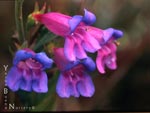
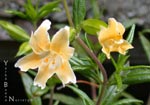
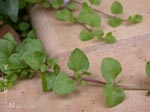 |
|
| Attract Birds, Butterflies and Pollinators | |
|
In a 2' wide pot, center one Penstemon eatonii for late spring hummingbirds. Plant two Erigeron glaucus across from one another, to attract spring-fall butterflies. Two Epilobium canum fill the remaining space, a draw for late summer hummingbirds. This design is recommended for a full sun location. Did you know? Hummingbirds need to feed year-round, so providing them with multiple food sources will bring them to your garden more often. |
|

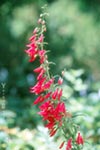
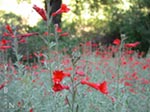 |
|
| For Areas of Partial Shade | |
|
With a Vaccinium ovatum in the center of a 2' wide pot, alternate three Festuca 'Siskiyou Blue' and three Oxalis oregana around the outside for a varying height and color combination. This design is best in a partial shade environment. Consider placing a container on your porch in an area that only gets direct sun for a short time each day. Did you know? A non-native, invasive form of Oxalis exists. Thankfully, we carry only the native variety! |
|
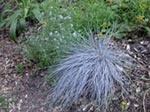
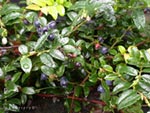
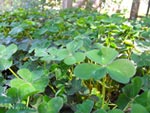 |
|
| Design Around a Centerpiece | |
|
Arctostaphylos 'Dr. Hurd' and 'Louis Edmunds' make fantastic container plants, adding a distinctly Native look to your arrangement. After centering your choice of Arctostaphylos in a 3' diameter pot, surround it with a collection of Sedum and Dudleya. This assortment will be happiest in a full sun location. Did you know? We have beautifully aged specimens of 'Dr Hurd.' and 'Louis Edmunds' at the nursery, ready to be planted in your garden or container. |
|
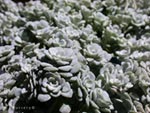
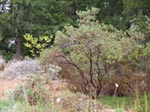
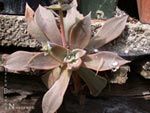 |
|
Garden Guides | At Your Home Garden Design Service | We've Gone Native Planting Service | Garden Tune-Up Service